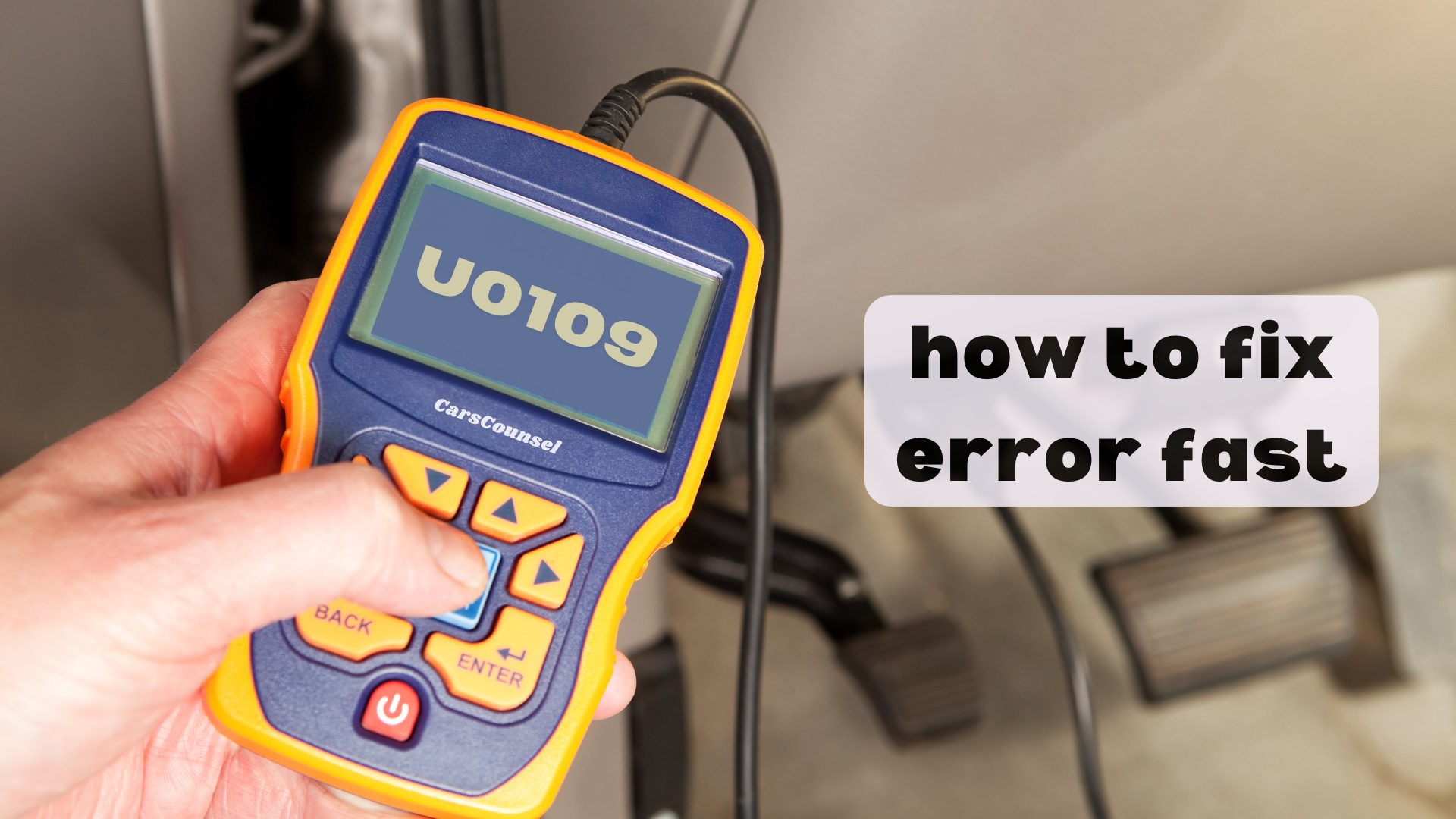When you see the U0109 code, it’s important to act quickly to avoid more OBD2 problems.
Start by visually checking the wiring and connections between the Fuel Pump Control Module (FPCM), Transmission Control Module (TCM), and Engine Control Module (ECM). Look for any signs of damage or rust, and use a multimeter to check for proper resistance and continuity.
If you find any issues with the wiring, fix or replace them right away.
But what if the problem is still there after fixing the wiring? Let’s explore the next steps to make sure your vehicle runs smoothly again.

Quick Navigation
Key Takeaways
- Use a code reader to get the U0109 code and see if there are any other error codes.
- Check the wiring and connections for any damage, rust, or loose ends, especially near the Fuel Pump Control Module (FPCM), Transmission Control Module (TCM), and Engine Control Module (ECM).
- Test the resistance in the wires and connections with a multimeter to find any high resistance or breaks.
- Update the ECM software to fix any communication problems between the modules.
What Is U0109 Code?
The U0109 code means there’s a problem with the communication between the Fuel Pump Control Module (FPCM) and other important parts of your car like the Transmission Control Module (TCM) and Engine Control Module (ECM). This can cause various issues with your vehicle.
To fix it, start by checking the wiring and connections, as damaged or corroded wires can often be the culprit. Regular maintenance of the fuel pump is also important. Make sure all parts are in good shape and free from corrosion.
Look for any software updates for your vehicle’s ECM. If everything else seems fine, you might need to replace the FPCM. Taking care of these things can prevent the code from coming back and help keep your car running smoothly.
Symptoms of U0109 Code
When you see a U0109 code, you might notice your engine misfiring, losing power, using more fuel, or having trouble starting. These problems mean that the Fuel Pump Control Module (FPCM) and the Engine Control Module (ECM) aren’t talking to each other properly, which can really mess up how your engine runs.
You might also find that your car stalls or won’t start at all. To keep things running smoothly, pay attention to these signs. Losing power and using more fuel can make driving less fun, and starting issues can leave you stuck.
Fix these problems quickly to keep your engine in good shape and avoid expensive repairs later. Catching these issues early can save you a lot of money.
Causes of U0109 Code
The U0109 code usually happens because of problems with wiring or loose connections, which mess up the communication between the Fuel Pump Control Module (FPCM), Transmission Control Module (TCM), and Engine Control Module (ECM).
If wires are damaged or corroded, they can’t send signals properly. Broken modules, like the FPCM, TCM, or ECM, can also cause communication issues.
Electrical problems, such as short circuits or open circuits, might trigger this code too. Additionally, software bugs in the ECM can stop proper communication.
Regularly maintaining your vehicle and using diagnostic tools are important to find these issues. Check the wiring, update the software, and make sure all connections are tight to prevent and fix U0109 code problems effectively.
Vehicles Affected by U0109
GM vehicles, especially Chevy, GMC, and Cadillac models, often deal with the U0109 code. This code comes up when there’s a communication problem with the Fuel Pump Control Module (FPCM).
Common signs include engine misfires, less power, poor fuel efficiency, and trouble starting the car.
Dodge Grand Caravan, Chrysler Sebring, and Dodge Durango can also have this issue. In these vehicles, you might see stalling or the car not starting at all.
While the U0109 code is less common in other brands, it can still happen. Knowing which specific models are likely to have this problem can help you fix it faster and keep the car running smoothly.
Using OBD-II Scanner
To figure out the U0109 code in your car, you’ll need an OBD-II scanner to check the error codes and see how well the ECM, TCM, and FPCM are talking to each other.
Start by plugging the scanner into the car’s diagnostic port. Use the scanner to pull up any stored codes and look at real-time data. This tool will help you find out if there’s a communication problem and identify any related codes.
Make sure the scanner works with your car model for accurate results. Using these tools, you can quickly find out if the problem is with the wiring, modules, or other parts, making the troubleshooting process easier.
Visual Inspection Tips
When you do a visual inspection, make sure you carefully check all the wiring and connections related to the Fuel Pump Control Module (FPCM) for any signs of damage, rust, or looseness.
Look for frayed wires, rust spots, or any disconnected parts. Focus on preventive maintenance by making sure all connections are tight and clean to avoid problems later on.
Use good troubleshooting methods: follow the wiring from the FPCM to the Transmission Control Module (TCM) and Engine Control Module (ECM), looking for any visible wear or damage.
Pay close attention to spots where wires might rub against other parts or where connectors might get dirty. A proper visual inspection is key to finding issues early and keeping your vehicle running at its best.
Resistance Testing Guide
Resistance testing helps you check if the wires and connections between the Fuel Pump Control Module (FPCM), Transmission Control Module (TCM), and Engine Control Module (ECM) are in good shape.
Start by disconnecting the battery to avoid any electrical shocks.
Use a multimeter to measure the resistance of the wires. Compare these readings to the numbers given by the manufacturer to see if anything’s off. Low resistance means the connection is good, while high resistance may indicate a problem.
Follow these steps carefully: measure, compare, and find any issues. This will help you locate any faulty wires or connections that might be causing communication problems between the modules.
Make sure to write down your findings and fix any issues quickly to solve the U0109 code.
Related OBD-II Codes
Check for other related OBD-II codes like P0627, P0628, and P0629, as they can give you more information about issues with the fuel system.
These codes usually point to problems with the fuel pump control circuit, such as low voltage (P0627, P0628) or high voltage (P0629).
Use a diagnostic scanner to look for these codes along with U0109. Finding these codes can help you figure out if the problem is with the fuel pump’s electrical system or the control modules.
By understanding how these codes are connected, you’ll be better prepared to fix communication issues.
Always double-check the codes and inspect the wiring and connections carefully to make sure you cover all bases.
Repairing Wiring Issues
Fixing wiring problems usually means carefully checking and fixing any damaged, rusty, or loose connections to get your vehicle’s systems talking to each other properly again.
Start by looking at the wiring diagrams for your specific car model. These diagrams will show you exactly how everything is connected.
Visually inspect all the relevant wires and connectors; look for any signs of wear, rust, or disconnection. Use a multimeter to check for continuity and resistance, making sure everything matches the manufacturer’s specs.
Clean or replace any rusty connectors and make sure all connections are tight. Pay extra attention to ground connections since these are crucial for the systems to communicate properly.
Often, fixing the wiring will solve the U0109 code without needing to do anything else.
Replacing Faulty Modules
Replacing faulty modules, like the Fuel Pump Control Module (FPCM), is crucial for getting your vehicle’s systems to talk to each other properly again.
First, use some basic troubleshooting to make sure the FPCM is really the issue. Disconnect the module and check for any damage or corrosion. Make sure the new module matches by comparing part numbers and manufacturer specs.
Install the new FPCM, ensuring all connections are tight and clean. After you replace it, clear any error codes with an OBD-II scanner and take the car for a test drive to make sure everything is working.
If problems continue, you might need to look at other modules like the Transmission Control Module (TCM) or Engine Control Module (ECM) and replace them if necessary.
Having working modules is key to keeping your vehicle running smoothly.
More OBD-II Codes
Frequently Asked Questions
Can Driving With a U0109 Code Cause Long-Term Engine Damage?
Driving with a U0109 code can affect how your engine runs, causing misfires and stalling. Using diagnostic tools can help find and fix the problem early, stopping any long-term damage to the engine from bad fuel pump communication.
How Much Does It Typically Cost to Fix a U0109 Error?
Fixing a U0109 error usually costs between $150 and $500. This includes the cost of diagnosing the problem and the actual repair, which could involve fixing the wiring, replacing the fuel pump control module (FPCM), or replacing the engine control module (ECM) or transmission control module (TCM).
Are There Any Temporary Fixes for a U0109 Code?
Think of it like a quick patch for a bigger issue. You can try resetting the ECU with diagnostic tools or making sure all connections are tight. But remember, these are just short-term fixes; you’ll need a proper repair to solve the problem.
Will a U0109 Code Affect My Vehicle’s Fuel Economy?
A U0109 code can hurt your vehicle’s fuel economy. When there’s a communication issue, the engine might misfire or not produce enough power. Using diagnostic tools can help you find the problem and fix it, so your fuel efficiency gets back to normal.
How Often Should I Check for Communication Errors in My Vehicle?
You should check for communication errors every time you do regular maintenance on your car. Doing this regularly helps catch problems early, keeps your car’s systems working well, and avoids future issues.
Conclusion
So, you’ve dealt with the U0109 code, checked the wiring, and even replaced some modules.
Funny enough, the simplest steps—like making sure all connections are tight—are often the last things we think about, but they usually fix most problems.
Now you’re the expert. Clear those error codes, take the car for a drive, and enjoy the peace of mind when the dashboard doesn’t light up like a Christmas tree.
It’s amazing how the smallest things can have the biggest impact, isn’t it?

